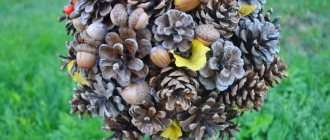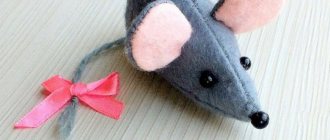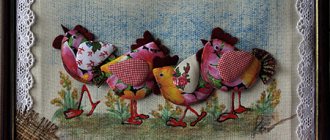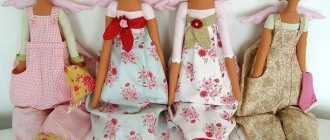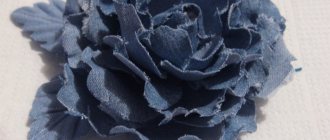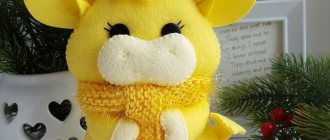Home stores offer a huge range of different textile items for the kitchen: towels, aprons, potholders, napkins, seat cushions. All these little things are practical, decorate the interior, and can add comfort and charm to even a faceless room.
This is not to say that finished products are very expensive, but why not save on something that you can do yourself and without any additional costs? It is best to start sewing experiments with basic things.
For example, first, study the question of how to sew oven mitts for the kitchen, and then begin to implement it. The simplest ones in shape - round or square - do not require any special sewing skills, or even a sewing machine!
Purpose of tacks
Potholders perform two important functions:
- serve to protect hands during cooking from hot cookware handles,
- decorate the interior.
Their last function is gradually becoming even more important. Very often, potholders are now sewn specifically for home decoration. They create coziness and help decorate the kitchen in a folk style. Pot holders sewn using the patchwork technique are especially good in this regard. They are appropriate in interiors in country style, a la Russe, Provence.
Oven mitts in the kitchen are a necessary attribute of any housewife.
Types of products and its fillers
Regardless of shapes, sizes, colors and application features, only two types of potholders are known:
- Textile;
- Silicone.
Flat, round
Textile
For fabric potholders, it is best to use material made from natural fibers: cotton, linen or chintz fabric. They are more durable, wear-resistant and tolerate high temperatures well.
Note! When heated, synthetic fabrics can lose their shape and become unusable very quickly. Plus, synthetics have the ability to ignite quickly, so you should be very careful when using a grip made from this material near an open fire.
The standard textile potholders are:
- Ordinary flat;
- Having the shape of a geometric figure: square, round or rectangular;
- In the form of a glove.
Filler. This is the key factor in protecting your hands from burns. When choosing filling, it is best to choose batting or drape; felt and flannel are also sometimes used - taking a hot kettle or pan with such filling will not be scary.
Pattern "Kitty"
Important! Pot holders with padding polyester instead of filler increase the risk of burns by 3 times than with drapery or batting. If it so happens that this was not discovered upon purchase, then it is best to use it as a decorative accessory.
Silicone
Silicone potholders are a modern approach to creating kitchen utensils. It has a wide functional range and is varied in design types. It also has a wide range of different shapes: clip, mitten, glove. Or in the form of animals: cats, pigs, dogs, mice, frogs, butterflies. The technical characteristics of this type of grips have many positive aspects, which allows them to increasingly gain popularity among housewives.
You might be interested in this: Creating patterns and sewing beautiful dresses for overweight women
Why is patchwork interesting?
Patchwork is a combination of various pieces of fabric in a certain sequence. The combination of geometric shapes allows you to create patterns of varying complexity. Quilting is considered a type of it. Here the art of appliqué, embroidery and stitching is added to the patchwork. Handmade potholders using elements of patchwork and quilting look extremely impressive and can even serve as an expensive gift.
Important: sewing potholders using this technique should be based on the art of combining fabrics by color. The easiest way is to combine plain fabrics and plain and colored fabrics. This is where you need to start getting acquainted with the patchwork technique.
Patchwork: beautiful and easy for beginners (photo)
The best posts
- Test No. 49 Find out the poet by his poems!
- Installation of a fireplace on the loggia and balcony
- Use of 3D wallpaper in the hall, features of the material
- Cross stitch pillows: DIY kits, Vervaco and Riolis patterns, ornament for sofa pillowcase, size
- How to choose a shellac lamp
- [Plants in the house] Amazon lily - Care at home
- Rating of pipe cleaning products for blockages
- Fiber for screed: consumption per 1m3, how much to add
Preparation of materials
Before you start sewing with your own hands, you need to prepare the materials. The selected new fabric must be washed and ironed. Washing is necessary for the fabric to shrink. Otherwise, shrinkage will occur during the process of using the product. After washing, the potholder may become deformed.
Important: you cannot use new and old fabric together without first washing the new one.
Before sewing potholders from new fabric, it must be prepared for work
You can use old scraps to sew potholders using the patchwork technique.
Pot holder in quilting technique
To make a potholder using the quilting technique, you will need:
- small scraps of fabric in different colors
- gasket (sintepon or thermal gasket with a layer of foil)
- paper, ruler, pencil
- needle, thread, pins, scissors.
The process of patchwork sewing potholders in this technique begins with the preparation of templates.
On paper, draw and cut out 19 hexagons. Their size is equal to the size of those hexagons that you see on your future potholder. For example, a hexagon measuring 5 cm with a side of 2.5 cm. You also need to cut out one hexagon of a larger size (about 1 cm on each side).
Use the large hexagon as a pattern, and use it to cut out 19 hexagons from the fabrics.
Place a small template on the wrong side of the cut piece. It's better to secure it with a pin.
Fold the edges of the fabric over the template and sew with basting stitches. Proceed the same way with the rest of the parts.
Then the two parts need to be folded with their front sides facing each other. Sew over the edge using regular stitches.
From the front side you will get something like this:
Continue sewing the pieces together. You will see that the result will be a kind of “flower”.
Then you need to iron everything thoroughly, pull out the basting and remove all the templates from the paper.
Now we cut out two squares from the fabric for the front and back sides of the potholder, and cut the same square from the spacer.
Assembling the potholder proceeds as follows: we fold all the layers of the potholder in sequence: the back, the gasket, the front side, the “flower”. Pin all layers together for security.
Now the potholder needs to be quilted. This means the stitch must go through all the layers, stitching the “flower” at the same time. The easiest way, of course, to carry out this process is with a sewing machine. You can also quilt the potholder by hand, making small forward stitches using contrasting threads. Hand stitching, of course, will take more time, but it will not lose the item. Cute, original, bright. But if this is a very long option for you, then the line can only be made along the “flower”. However, if each hexagon is quilted, the volume and pattern will be better emphasized.
Next, you need to cut a long strip 5 cm wide from the fabric, its length should be 15 cm greater than the perimeter of the product. Carefully fold both sides of the strip inside out. Iron it.
Now you need to edge the potholder. The strip of fabric must be sewn with the same seam “forward to the needle”.
As soon as you reach the corner, you need to carefully wrap the strip and continue making the stitch on the other side of the potholder itself. The edging should begin from the place where the loop will subsequently be located.
You can also edge the potholder using a sewing machine, if you know how to do it.
The final part of the work. After completing the edging, point the strip of fabric upward. Continuing to stitch, we form a loop. Wrap the strip onto the wrong side of the potholder and sew it on.
Well, the pot holder using the quilting technique is ready!
Yes, beginners may be intimidated by the lengthy instructions and the seemingly lengthy process. But in fact, everything is done quite quickly, and once you get the hang of it, patchwork will no longer be a labor-intensive process for you. Rather, on the contrary, you will only be looking everywhere for scraps for future work. You'll start with a potholder, then sew a blanket for your daughter's favorite doll, and then an adult patchwork blanket will come out from under your hands.
Patchwork is a common type of needlework. Even in small towns there are clubs and studios where craftsmen learn all its wisdom. You can also master patchwork on your own; master classes for beginning needlewomen will continue to be held at Krestik. Good luck with your creativity!
Choice of motives
The next step is choosing a tack pattern. It can be done in different ways.
So, what kind of potholders can be:
- in classic patchwork style,
- with applique,
- with embroidery.
Combinations of these styles are quite appropriate. The simplest is to sew potholders using a simple patchwork technique. And only after mastering it, you can start making appliqués from scraps. The applique can be made up of different patches, or a ready-made motif cut from fabric can be sewn on top of a panel sewn using the patchwork technique.
There are many patterns and techniques for sewing a classic patchwork potholder.
The application can be:
- flat,
- volumetric.
The volumetric applique looks especially impressive. It’s not difficult to make it with your own hands from scraps - just put a padding polyester or holofiber under the sewn parts.
Patchwork: master class for beginners
Special comfort in the interior is created by handmade items, in particular, beautiful and comfortable pillows. Let's try to sew a decorative pillowcase with a voluminous "Rose" application using MK. You can take any scraps for work, the main thing is that they match well in color. Don't forget to prepare the fabric - wash it, iron it.
Master class “Pillow with applique”
Step-by-step instruction .
- It’s convenient to start by preparing squares. Their number and size determine the size of the pillow.
- Then you need to cut a circle out of the fabric. In the middle, put a piece of fabric and some filler for volume (cotton wool, padding polyester). Secure in a circle using a machine stitch. The middle is ready.
- Fold the squares from the flaps diagonally, as in the photo, sew around the middle piece in a circle - 3-5 pieces.
- For the next round you need to prepare large squares of the corresponding color. Continue until the end of the intended flower size.
- The sewn petals must be trimmed in a circle.
- The finished roses are beautifully distributed on a pillowcase and secured to the product with a zig-zag seam and a wide, dense stitch. The rosette has the appearance of a three-dimensional appliqué.
- If desired, the bouquet can be supplemented with leaves cut from scraps of a suitable color. Look at the photo for a step-by-step master class. The blanket in MK is made using the “crazy patchwork” technique (you can watch video tutorials), and it consists of 30x30 cm squares. For a single blanket you need 24 pieces, for a double blanket – 36. Let’s say the pattern will be made up of 4 types of fabric.
Related article: Warm water floor from a gas boiler in an apartment
The complexity of the ornament depends on the experience and skills of patchwork sewing
Master class “Patchwork for beginners - blanket”
Tools and materials:
- 1 m of fabric of each color (width 220 cm) - 6 or 9 squares 45x45 cm;
- For the lining - 170 cm or 220 cm (the margin at the bottom goes away after the blanket is quilted);
- Sintepon of similar sizes;
A blanket or bedspread can be sewn from simple squares or complex pieces
Step-by-step instructions for MK:
- Cut into squares and stack, alternating colors.
- Cut this layer cake diagonally or randomly. It is convenient to cut with a roller knife.
- Take the part from above and move it down under a stack of similar elements. In a cut stack there will be 1 piece of the 1st color on top and 1 piece of the 2nd color.
- Machine sew all the squares along the cut line.
- On an ironing board, carefully press the seams to one side or press them flat.
- Fold the blanks into a neat stack in the same order - squares of the 1st and 2nd tones on top.
- Using a ruler and a knife, cut the entire stack again along any line (you can cross the first seam).
- Move one of the top fragments down under the stack. Sew and press, remembering to fold in order - now it’s better to match the seams.
- The operation is repeated until the last detail. The optimal number of seams is 6-10 horizontally and vertically.
- After ironing the seams, you need to trim the squares to get a figure with a side of 32 cm.
- You can assemble the blanket in different ways: first assemble the front part, then quilt it with padding polyester and lining. It's difficult on a typewriter. Or quilt each square separately, cutting padding and lining.
- Gather the quilted squares together, trim and cover the seams with narrow tape or strips of fabric. It is convenient to assemble according to the scheme: ribbons of 4-6 squares, then sew the strips.
- Along the edge of the blanket, you also need to trim it with an edging made of plain fabric or pieces of rags, as in the MK photo.
Congratulations on your new look!
Schemes for tacks
You can search for ready-made diagrams on the Internet. Today there are a large number of them. But not all patterns are suitable for sewing potholders in the patchwork style.
Let's look at what schemes there are.
The most basic patterns:
- "Squares"
- "Ohio Star"
- "Carousel or mill"
- "Hourglass"
- "House"
- "Solomon's Star"
- "Vortex",
- "Russian".
Sewing from squares is a universal patchwork that can be used to make potholders with your own hands. This is the simplest method, so in order for the potholders to turn out original, it is worth using additional tricks. For example, you can place embroidery in each square or sew an applique on top of the base.
Patchwork crazy does not imply drawing up specific patterns, only consistency is important
For sewing potholders, the remaining patterns can be used as a separate independent element. Particularly good in this sense are such schemes as the Ohio star, mill, Solomon star, Russian, where combinations of triangles and squares are used. This patchwork technique allows you to achieve interesting effects.
The simplest patchwork potholder can be sewn according to the “hourglass”, “house” or “square” pattern
“Ohio Star” is a classic pattern for patchwork products that requires certain skills in working with fabrics
Quilting for Beginners
Patchwork is very popular today - a handicraft in which colored scraps of fabric are assembled into a whole product with a planned pattern based on the principle of a mosaic. The result of such a fascinating process can be a recognizable image of some objects, geometric patterns or fancy patterns. Ideas for patchwork can be taken from photo and video lessons, as well as master classes.
Initially, the patches were sewn together to save material, and the patchwork had very specific tasks. Now the patchwork technique is the desire to create beauty while enjoying this magical action. Quilted bedspreads, decorative panels, blankets and pillows, oven mitts, updated furniture, and clothes are pleasing to the eye.
To understand the basics of patchwork technique, you need to get acquainted with its main types in master classes and videos
Patchwork Basics :
- Accuracy and accuracy . The patchwork technique is not a complicated technology, but realizing the idea, as in MK, is not always easy. The guarantee of success in patchwork is accuracy and precision. Patterns for potholders or blankets must be precise and very neatly sewn. The fabric requires pre-treatment (decatation). It needs to be soaked or washed, dried and ironed, sorted by color.
- Working with an iron . The iron is an important tool in patchwork. During work, the seams must be ironed; when decatching fabrics, they must also be ironed. Ready potholders or bags are steamed from the front side and always in one direction. The seams also need to be pressed in one direction. Then they will not crumble and will be durable. Seam allowances are smoothed from the inside out so that no marks remain on the front side. In complex blocks where seams meet in different directions, the allowances of each next row are ironed in a different direction. On the front side, iron at the intersection points of the seams. If the strips are too long, they should be placed on the ironing board not horizontally, but vertically - they will not wrinkle or stretch. Fabric that is too thick is moistened and steamed. The fabric is ironed lengthwise at a temperature appropriate to the type of fabric.
- Sewing secrets . Carelessly sewn fragments of a future potholder or napkin, uneven seams, even a slight discrepancy in sizes will destroy patchwork sewing for beginners. Therefore, the flaps must be sewn in very precisely. Beginning craftswomen will be helped by templates in the form of a frame, which are made on graph paper with a seam line printed on the fabric. Before starting a huge project, it is recommended to sew a sample block. It will help you check the cutting accuracy and adjust the operation of the sewing machine. It is easy to see all the errors on the sample - this will save both time and effort.
Article on the topic: Ventilated facade - technology for installing suspended facade systems with an air gap
It is much more difficult to correct errors on a finished canvas.
In general, the patchwork technique should be taken seriously, considering all color combinations even for potholders - after all, they, like sloppy work, can ruin the item and discourage you from mastering such an exciting handicraft.
How to sew
In patchwork style, only the front part of the product, located on the outside of the palm, is sewn. The back side is sewn from plain fabric.
The tack itself consists of the following parts:
- patchwork sides,
- the sides of the mittens are made of plain fabric,
- gaskets or insulation,
- two internal lining parts, which can be sewn from the same plain fabric.
The gasket is designed to make the product thicker and help it perform its main function - to protect it from high temperatures during operation. You can use padding polyester or batting as a padding.
Any tack using the patchwork technique requires a dense base.
A dense lining can serve as the basis for a composed pattern
A pattern is first made in the form of a regular mitten. Next, the front part is sewn according to the pattern in patchwork style. If the simplest patchwork technique of sewing with squares is used, then a panel is sewn, and then a part is cut out of it according to the pattern.
Next, the back part, gasket parts, and internal lining parts are cut out.
Assembling the artichoke-style potholder is done in stages
Modern options for potholders
Not long ago, silicone potholders in the shape of a duck beak, a dog's mouth, and a frog's face appeared on sale. They consist of two halves: one for the thumb, the second for the other four fingers. With the help of such an oven mitt it is convenient to remove baking dishes from a hot stove.
Is it possible to sew something like this? Certainly! The main difference between this potholder and the others is three parts: one large and two smaller. As a training sample, you can sew an oval or rectangular potholder.
Manufacturing technology:
- Draw a 25x20 cm rectangle on a sheet of paper;
- transfer it to the main fabric folded in half, cut it out to make 2 parts;
- using this template, make parts from cushioning material;
- fold so that the filling is between the wrong sides of the base, sew;
- repeat steps 1-3, but cut each part into two identical parts;
- Sew two blanks from the resulting halves and finish the outer sections with braid or trim;
- place two small ones with processed cuts facing each other onto a large workpiece to create pocket-flaps facing each other;
- sew around the perimeter, decorate the seams, sew on a loop.
Now you can roll up the pot holder to check the fit.
Tip: An oven mitt with flaps can be used as a cutlery pocket for table settings.
Using this pattern, you can sew an oven mitt, which can be used to conveniently hold a saucepan or ceramic pot. It looks like a scarf with pockets on the edges. The length of the largest piece is calculated based on the size of the largest pan used. It is necessary to measure the diameter and add 20 cm. Width – 20 cm. For two small parts, cut out rectangles 15x20 cm.
Assembling the potholder
The tack assembly is done last.
First, sweep the following parts together:
- front side, gasket and inner lining,
- reverse side, gasket and inner lining.
Next, both resulting parts are sewn together, like a regular mitten. Turn the potholder inside out, process the edges and sew on a loop made of the same color material used. The DIY potholder is ready.
